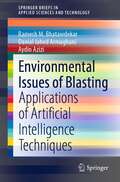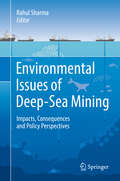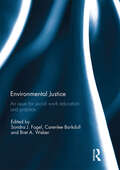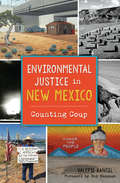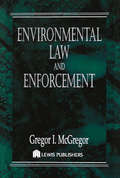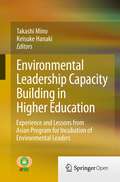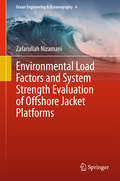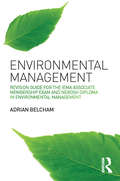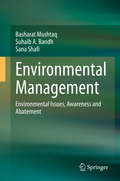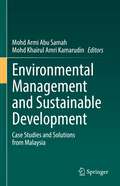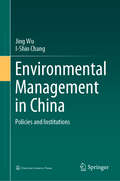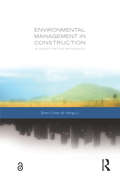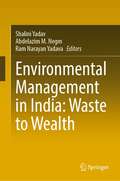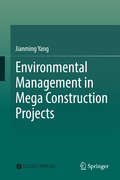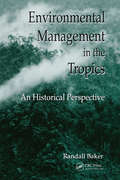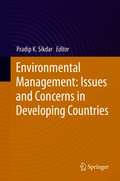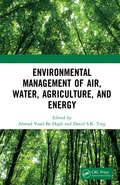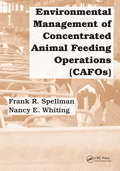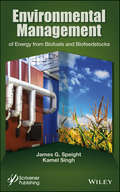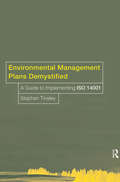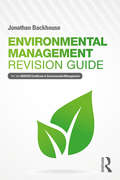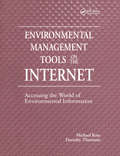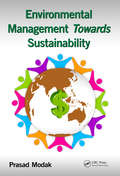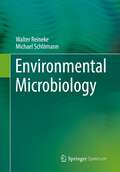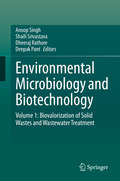- Table View
- List View
Environmental Issues of Blasting: Applications of Artificial Intelligence Techniques (SpringerBriefs in Applied Sciences and Technology)
by Aydin Azizi Danial Jahed Armaghani Ramesh M. BhatawdekarThis book gives a rigorous and up-to-date study of the various AI and machine learning algorithms for resolving environmental challenges associated with blasting. Blasting is a critical activity in any mining or civil engineering project for breaking down hard rock masses. A small amount of explosive energy is only used during blasting to fracture rock in order to achieve the appropriate fragmentation, throw, and development of muck pile. The surplus energy is transformed into unfavourable environmental effects such as back-break, flyrock, air overpressure, and ground vibration. The advancement of artificial intelligence and machine learning techniques has increased the accuracy of predicting these environmental impacts of blasting. This book discusses the effective application of these strategies in forecasting, mitigating, and regulating the aforementioned blasting environmental hazards.
Environmental Issues of Deep-Sea Mining: Impacts, Consequences and Policy Perspectives
by Rahul SharmaThis volume discusses environmental issues associated with deep-sea mining, with an emphasis on potential impacts, their consequences and the policy perspectives. The book describes the methods and technologies to assess, monitor and mitigate mining impacts on marine environments, and also suggests various approaches for environmental management when conducting deep-sea mining. The volume brings together information and data for researchers, contractors, mining companies, regulators, and NGOs working in the field of deep-sea mining. Section 1 highlights the various environmental issues and discusses methods and approaches that can help in developing environmentally sustainable deep-sea mining. Section 2 details the results and outcomes of studies related to impact assessment of deep-sea mining, and proposes methods for monitoring. Section 3 discusses the need and means for developing data standards and their application to deep-sea mining. Section 4 discusses the policies, approaches, and practices related to deep-sea mining, suggests formats for developing environmental impact statements (EIS) and environmental management plans (EMP), and describes national and international regulations for environmental management. Section 5 concludes the text by putting deep-sea economic activities into an environmental context and conducting techno-economic analyses of deep-sea mining and processing.
Environmental Justice: An Issue for Social Work Education and Practice
by Sondra J. Fogel Carenlee Barkdull Bret A. WeberWhat is environmental justice? Why is it important to social work? Social work has a long history with the term "environment" as part of our guiding Ecological Framework. Yet frequently, the assessment of the environment is left out or seen as a difficult domain to understand as part of the complexities of the human experience, particularly for those who are vulnerable, oppressed and poor. This book contains nine articles that showcase environmental justice work in social work practice and in educational settings from around the world. The profession now seems ready to ensure that the "environment" is once again given the consideration it deserves when we are assessing problems in living. These articles were selected for their helpfulness in moving the profession forward conceptually while offering practical tools for the classroom, institutions, and for further scholarship. This book was originally published as a special issue of Social Work Education: The International Journal.
Environmental Justice in New Mexico: Counting Coup (Natural History)
by Valerie Rangel Bob HaozousIn New Mexico and across America, communities of color bear the brunt of contamination from generations of expansion, mining, nuclear testing and illegal dumping. The nation's largest uranium waste spill occurred in 1979 at Church Rock, and radioactivity in the Rio Puerco remains at dangerous levels. The National Trust for Historic Preservation listed Mount Taylor as one of the ten most endangered historic sites in America. After decades of sickness from Rio Grande river water, the first female governor of a Pueblo Nation, Verna Olgin Teller, led tribal members to a Supreme Court victory over Albuquerque. Valerie Rangel presents stories of strife and struggle in the war to protect the integrity of natural systems, rights to religious freedom and the continuation of traditional customs.
Environmental Law and Enforcement
by Gregor I. McGregorAmid all the laws and regulations on environmental protection and worker safety, what is the responsible business or landowner to do? What should the responsible consultant advise? Environmental Law and Enforcement provides you with a practical guide that takes the mystery out of environmental law and related land use controls.The author provides a synopsis of major environmental topics from A to Z and features citations to the major federal statutes in the United States Code (USC) and the Code of Federal Regulations (CFR) so you can easily find governing statutes and regulations. Special sections discuss the use of experts in case preparation and how to be an effective case witness. A checklist for compliance with the National Environmental Policy Act is included. The book covers strategies to cope with landowner liability for hazardous waste, consultant liability for mistakes in hazardous waste site assessments, and guidelines for emergency managers to minimize legal liability. The section on insurance liability provides practical approaches to dealing with insurance companies on hazardous waste claims. The successful organization will manage for environmental protection as a corporate goal, and consequently stays ahead of new government requirements-away from lawyers and lawsuits-and ahead of the competition. Environmental Law and Enforcement gives you the tools you need to achieve this mission.
Environmental Leadership Capacity Building in Higher Education: Experience and Lessons from Asian Program for Incubation of Environmental Leaders
by Keisuke Hanaki Takashi MinoThe Graduate Program in Sustainability Science under the Department of Urban Engineering of The University of Tokyo has been running an environmental leadership education program at the graduate student level since 2007 called the Asian Program for Incubation of Environmental Leaders (APIEL). This book describes the University's experiences in establishing and organizing that program and provides some lessons learned for those who are considering starting environmental leadership education programs. APIEL's curriculum includes the classroom topic "Environmental Challenges and Leadership in Asia." As well, the APIEL program has field units to provide experience in problem solving, decision making, and participation, taking into consideration ecological, political, economic, social, aesthetic, and ethical aspects. Another characteristic feature of the program is that it promotes changes in attitudes and behavior that will help to solve existing environmental problems and to avoid a generation of new ones. Over the four years of study, efforts have been made to bond leadership with field-oriented exercises such as: 1) The Intensive Program on Sustainability; 2) an integral approach focused on sustainable integrated watershed management of arid regions; 3) sustainable development of programs in Cambodia, Vietnam, and Thailand for qualifying students with problem-solving processes to combat issues such as flooding, lack of proper urban environmental infrastructure, and health risks; and 4) the Greater Pearl River Delta program with multicultural diversity to bring about sustainable urban development for a green city. All of those are described in the book. Last but not least, APIEL's resonance throughout international networks and alumni are introduced.
Environmental Load Factors and System Strength Evaluation of Offshore Jacket Platforms
by Zafarullah NizamaniThis book presents a study for the determination of environmental load factors for Jacket Platforms in Malaysia and a methodology to determine the life extension of aging platforms. The simplified methods described here could be used for determining not only structural reliability but also safety factors. Its content is particularly interesting to design and maintenance engineers who are working in offshore or onshore industry.
Environmental Management: Revision Guide for the IEMA Associate Membership Exam and NEBOSH Diploma in Environmental Management
by Adrian BelchamWritten by Adrian Belcham, author of Manual of Environmental Management, this is the essential guide to prepare you for the IEMA Associate Membership Exam and NEBOSH Diploma in Environmental Management. Through the inclusion of revision tips, exam guidance and self-test questions, this guide will consolidate your understanding of environmental management and help you to prepare for your exam. It provides full coverage for both the IEMA and NEBOSH exams and includes coloured sections to help you to identify the content relevant for each qualification. Small, handy size ideal for on the move Illustrations and tables to improve understanding Written by expert tutor of IEMA and NEBOSH environmental qualifications.
Environmental Management: Environmental Issues, Awareness and Abatement
by Basharat Mushtaq Suhaib A. Bandh Sana ShafiIn the current age of science and technology, our lives have become dominated by countless scientific and technological innovations without which the earth would be a much poorer place. Life as we know would become absolutely bleak and boring without the inventions and advances being made all over the globe. In fact, scientific inventions, discoveries and innovations have ushered in a dramatic revolution in virtually every sphere of life. But at the same time, the skewed use of technology is at loggerheads with the environment. We, and our environment, now face a number of critical challenges and it is in response to this that we wrote this book to raise awareness for environmental issues and related management aspects. With a primary focus on Environmental Management – the rational reconciliation of man and nature, which involves the judicious exploitation and utilization of natural resources without disturbing the ecosystem’s balance – it will thus help to improve the relationship between man and environment. Moreover, it offers a wealth of ready-to-use material for advanced undergraduate and graduate students of Environment and Water Management. The book systematically addresses a range of key aspects, e.g. scientific principles, methods and ideas, as well as life-long learning skills for students. Further, it provides a solid foundation for applying scientific approaches to environmental problems.
Environmental Management and Sustainable Development: Case Studies and Solutions from Malaysia
by Mohd Armi Abu Samah Mohd Khairul Amri KamarudinThis volume provides case studies conducted in Malaysia based on environmental management and the sustainable development of human and ecological systems. The first chapter discusses awareness studies in environmental management in Terengganu, Malaysia. The second chapter is about human health risk assessment of heavy metals exposure due to freshwater fish ingestion from Sungai Kuantan, Malaysia. The third chapter discusses nickel and cadmium pollution in freshwater fishes in Kuantan River and Riau River. Chapter four discusses tourism sustainability. Chapters five and six provide an overview on particulate matter emissions at construction sites, and municipal solid waste (MSW) management approaches. In chapter seven, the book provides a general overview on cellulose and cellulose nanocrystals extraction. Finally, chapters eight and nine discuss legal measures for wildlife protection in Malaysia, and how improved environmental management practices are needed to achieve this. The book is intended for environmental managers, wildlife organizations, and students and researchers studying sustainable development, waste management, and corporate impacts on the environment.
Environmental Management in China: Policies and Institutions
by Jing Wu I-Shin ChangThis book details various stages in the introduction, establishment and evolution of China’s environmental management system. By combining a literature review, comparative analysis, and case study, it investigates the environmental management system in several key periods in order to systematically assess the necessary measures and appropriate adjustments the Chinese Government implemented to reconcile the growing conflicts between economic development and resources conservation, in the context of rapid economic growth and economic transformation. Given its scope, the book offers a valuable resource for experts, scholars, and government officials in related fields.
Environmental Management in Construction: A Quantitative Approach
by Heng Li Zhen ChenDemands on the construction industry are changing, and it is now virtually essential for environmental management to be considered at all stages of a project. Many construction managers are finding a quantitative approach useful, and this book outlines four quantitative methods which can be applied at different construction stages, and which fit within a comprehensive framework of dynamic Environmental Impact Assessment (EIA). These include: a method to quantitatively evaluate and reduce pollution and hazards levels a method to evaluate the environmental-consciousness of proposed construction plans a method to reduce on-site construction wastes through an incentive reward programme a method to promote C and D waste exchange in the local construction industry. With an experimental case study of the application of these methods, this book delivers a comprehensive review of environmental management issues in construction. With regulatory requirements potentially favouring the quantitative approach, this timely guide ensures that contractors will be able to keep pace with environmental management standards.
Environmental Management in India: Waste to Wealth
by Shalini Yadav Abdelazim M. Negm Ram Narayan YadavaThis book presents unique connectivity between waste management within the agenda 2030 of India. This book is the first publication presenting up-to-date work and knowledge about waste management and waste technologies to transfer waste to wealth in India. Besides, this book also presents the role of waste management and its contribution to achieving a sustainable development program in India, with vast implication worldwide. The main focuses of the book include waste and wealth and the associated technologies, recycling of solid waste, utilization of hazardous waste, use of nanoparticle in waste management, urban solid waste, generation of energy from organic waste, clean technologies, and use of waste in agriculture. The book is a unique source of information on the transformation of waste to wealth in India. This book is of interest to research communities in the field of waste management in India, and in similar socioeconomic countries, but also, due to the planetary implications, has global interest.
Environmental Management in Mega Construction Projects
by Jianming YangThis book discusses environmental management and construction management approaches to the environmental problems that can emerge in construction projects. It sets a brand new standard for environmental management in mega construction projects in China and helps all construction project stakeholders establish a more compliant and efficient environmental management system. The authors systematically explore management systems and team management, offering managerial methods and tips based on international and Chinese practices. Outlining all the environmental challenges that can arise during construction, it is a valuable resource for company owners, construction contractors, and construction management consultants and companies. It also offers useful insights for engineers, project managers and project executives.
Environmental Management in the Tropics: An Historical Perspective
by Randall BakerThe arrival of western science and economic interests to the tropics has dramatically changed the tropical environment and its ecology. Environmental Management in the Tropics discusses the ecology of the tropics and examines how it is different from the temperate zone where western science evolved. The author discusses how native people traditionally subsisted in different ecological zones of the tropics and how they rationalized their relationship. The author also takes a critical look at the impact of colonialism in the tropics and how it changed traditional cultures and their relationship with the environment. The current clash between economics and ecology in the tropics is explored in depth. According to the author, we are now able to draw "a line in the sand" and illustrate the consequences of continuing current practices. Environmental Management in the Tropics shows how this situation developed and discusses how the two opposing concepts must be brought back into harmony. The book is one of the few studies to take a truly interdisciplinary approach combining the serious inevitabilities of natural science with the variables of history, culture, politics, and economics. It gives us a new respect for the past and tradition of the tropics and clearly spells out why dramatic changes must occur to prevent further degradation of the tropical environment.Environmental Management in the Tropics is an important reference for ecologists, conservationists, scientists, researchers, environmental consultants, land managers and developers, members of the world regulatory community, and anyone working on projects in tropical regions.
Environmental Management: Issues and Concerns in Developing Countries
by Pradip K. SikdarThis book deals with issues and concerns for the human environment in the developing countries incorporating natural processes and systems, pollution removal technology, energy conservation, environmental impact assessment process, economics, culture, political structure and societal equity from a management point of view. Solutions to the emerging problems of the environment need a paradigmatic shift in approach from a process based model to a socio-political-economic model. Hence environmental management should involve equality and control over use of the finite natural resources and the balance between Earth’s biocapacity and humanity’s ecological footprint. Changes such as green technologies, human population stabilization and adoption of ecologically harmonious lifestyles are absolutely essential and will require redesigning of political institutions, policies and revisiting forgotten skills of sustainable practices of environmental management. These challenges should centre on environment governance using the concepts of common property, equity and security.This book is relevant for academics, professionals, administrators and policy makers who are concerned with various aspects of environment management and governance.
Environmental Management of Air, Water, Agriculture, and Energy
by Ahmad Vasel-Be-Hagh David S.K. TingEnvironmental Management of Air, Water, Agriculture, and Energy brings together the most current state of knowledge on four major elements for sustaining life on planet Earth: air, water, food, and energy. It examines how green technology aids in mitigating the global water, energy, and climate change crises, including the use of electrostatic force and green infrastructure. The concepts of underwater vegetation and aquatic cultivation, as well as vertical farms, are presented to spark discussion on emerging water-energy-food nexus lessons, experiences, and opportunities. This book takes a comprehensive global-scale approach to examining potential future environmental scenarios and outcomes. Features: Analyzes the most recent research findings in each of the areas covered Synthesizes the state-of-the-art understanding Recommends ways to strive forward and to shape future research Serves as an educational tool for educators and students Supported by detailed examples and case studies, this book serves not only as an up-to-date source of information for environmental experts and researchers in the field, but also as an educational tool for relevant undergraduate and graduate courses. It is also suitable for industry professionals concerned with preserving planet Earth for generations to come.
Environmental Management of Concentrated Animal Feeding Operations (CAFOs)
by Frank R. Spellman Nancy E. WhitingClean and environmentally sound disposal of animal waste in the quantities that Concentrated Animal Feeding Operations (CAFOs) produce can only be described as a challenge. Designed to provide practical information, Environmental Management of Concentrated Animal Feeding Operations (CAFOs) covers the concepts and practices involved in the operation
Environmental Management of Energy from Biofuels and Biofeedstocks
by James G. Speight Kamel SinghBiomass is a renewable resource, whose utilization has received great attention due to environmental considerations and the increasing demands of energy worldwide. Since the energy crises of the 1970s, many countries have become interested in biomass as a fuel source to expand the development of domestic and renewable energy sources, reduce the environmental impacts of energy production provide rural prosperity for its poor farmers and bolster a flat agricultural sector. Biomass energy (bioenergy) can be an important alternative in the future and a more sustainable energy. In fact, for large portions of the rural populations of developing countries, and for the poorest sections of urban populations, biomass is often the only available and affordable source of energy for satisfying basic needs as cooking and heating. The focus of this book is to present a historical overview, country perspectives, the use of biomass to produce biofuels, the current and upcoming sources of biofuels, technologies and processes for biofuel production, the various types of biofuels and, specifically, the ways and means to make biofuel production sustainable, economically feasible, minimize environmental damage and to deliver on its many promises.The Energy and Environment book series from Scrivener Publishing and series editor, James G. Speight, aims to cover the environmental impacts and social concerns of energy production in its various forms. This first volume in the Energy and the Environment series offers a comprehensive coverage of one of the fastest-growing and most important sources of energy, biofuels. Future volumes will cover oil and gas, wind and solar energy, and their environmental aspects.
Environmental Management Plans Demystified: A Guide to ISO14001
by Stephen TinsleyThe development of an environmental management plan is an essential business activity that helps organise, direct and control operational activities, and plan for future environmental risk. Once created, an environmental management plan is an ongoing asset that requires regular updating and enables benchmarking against company targets and competitors. Environmental Management Plans Demystified takes you step-by-step through the process and procedures required to implement a successful plan. Its clear, accessible style allows you to achieve ISO 14001 compliance with the minimum of effort. Examples of standard documentation, case studies, flowcharts, and checklists are included, as well as useful hints to avoid resource-wasting pitfalls. If you want to install a successful environmental management plan that will minimise environmental risk and create a competitive advantage for your company, this book is an essential practical guide for both the absolute beginner and the experienced practitioner.
Environmental Management Revision Guide: For the NEBOSH Certificate in Environmental Management
by Jonathan BackhouseThe Environmental Management Revision Guide: For the NEBOSH Certificate in Environmental Management is the perfect revision aid for students preparing to take their NEBOSH Certificate in Environmental Management. As well as being a handy companion volume to Brian Waters’ NEBOSH-endorsed textbook Introduction to Environmental Management, it will also serve as a useful aide-memoire for those in environmental management roles. The book aims to: Provide practical revision guidance and strategies for students Highlight the key information for each learning outcome of the current NEBOSH syllabus Give students opportunities to test their knowledge based on NEBOSH style questions and additional exercises Provide details of guidance documents publically available that students will be able to refer to. The revision guide is fully aligned to the current NEBOSH syllabus, providing complete coverage in bite-sized chunks, helping students to learn and memorise the most important topics. Throughout the book, the guide refers back to the Introduction to Environmental Management, helping students to consolidate their learning.
Environmental Management Tools on the Internet: Accessing the World of Environmental Information
by Michael KatzThis book provides general information about what is on the Internet and how to access it. It shows how o get environmental information off of the Internet. The book covers the database services that are available on the Internet that charge fees.
Environmental Management towards Sustainability
by Prasad ModakThis book is about understanding challenges in managing our environment and ensuring sustainability of this planet. It presents the critical state of our resources and threats to resource security due to overconsumption, pollution and poor and uneven governance. Role of key stakeholders such as the Government, Financing Institutions, Business and Communities is important. These stakeholders need to collaborate at multiple levels – viz. Local, Regional, National and Global. Chapters are devoted to describing the role of the above stakeholders with numerous case studies. The book can serve as a textbook to academia, a reference for policy makers and planners and a resource for conducting continuing education programs for the professionals to introduce both the concepts and practice experience on sustainability.
Environmental Microbiology
by Walter Reineke Michael SchlömannThis textbook addresses global and local environmental problems and the involvement of microorganisms in their development and remediation. In particular, methodological aspects, some of them molecular genetic, for the study of microbial communities are considered. Overall, the prominent role of microorganisms in various material cycles is presented. In addition to biochemical principles for the degradation of environmental pollutants, the use of microorganisms in environmental biotechnological processes for the purification of air, water or soil as well as in environmentally friendly production processes is discussed. The book is intended for biologists with an interest in environmental microbiological issues, but also for students of process or environmental engineering, geoecology or geology, as well as students of other environmental science disciplines. For the 3rd edition, the authors have completely revised, corrected, updated and supplemented the book.
Environmental Microbiology and Biotechnology: Volume 1: Biovalorization of Solid Wastes and Wastewater Treatment
by Anoop Singh Shaili Srivastava Dheeraj Rathore Deepak PantThis book provides up-to-date information on the state of the art in applications of biotechnological and microbiological tools for protecting the environment. Written by leading international experts, it discusses potential applications of biotechnological and microbiological techniques in solid waste management, wastewater treatment, agriculture, energy and environmental health. This first volume of the book “Environmental Microbiology and Biotechnology,” covers three main topics: Solid waste management, Agriculture utilization and Water treatment technology, exploring the latest developments from around the globe regarding applications of biotechnology and microbiology for converting wastes into valuable products and at the same time reducing the environmental pollution resulting from disposal. Wherever possible it also includes real-world examples. Further, it offers advice on which procedures should be followed to achieve satisfactory results, and provides insights that will promote the transition to the sustainable utilization of various waste products.
